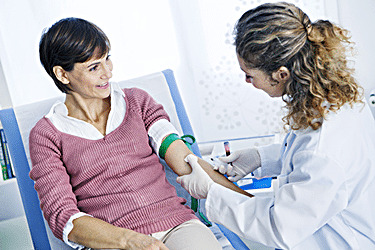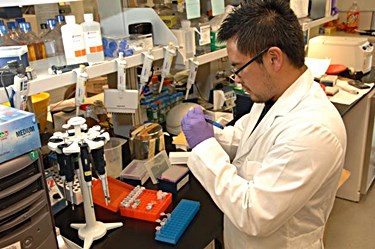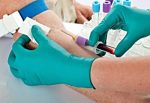If you’ve decided to train to become a phlebotomist, you’ll likely discover that there are two main routes to take to get started: You can receive your training in the workplace, or you can attend a phlebotomy school that offers an official training course and certification.
If you’re not already in the medical field and you don’t have any experience in phlebotomy, choosing the training program is usually a better way to go to get the proper resources needed to become a professional phlebotomist. But, how do you know what to look for in a phlebotomy school?
There are certainly some online training programs and schools that are better than others, and without a bit of knowledge at your fingertips, it can be hard to pick out the ‘good’ from the ‘bad’ at times. Let’s first take a look at what you’ll study in phlebotomy school, and what you can expect from a quality, solid program. From there, we’ll go through some tips you can use when it comes to choosing a good program, and weeding out ‘shady’ training solutions that offer little more than empty promises.
What to Look for in a Phlebotomy School
Though every phlebotomy school will be a little bit different, they will all cover the same basic topics and methods to fulfill the accepted requirements, and even certification if needed. You can expect everything from coursework, to hands-on work, and even lessons in dealing with patients every day. Most phlebotomy training programs will feature the following subjects:
Anatomy
In training to be a phlebotomist, it’s important to know the human body inside and out. Most training programs will cover anatomy, and the systems of the body, including circulatory, respiratory, and nervous systems. You’ll learn the functions of different organs, as well as the general composition of blood cells, and what they do within the body itself. The circulatory system will be your main focus.

Venipuncture
This is the very act of drawing blood – a phlebotomist’s primary job when working with patients. At a typical school, you’ll learn various drawing techniques, how to find a vein quickly, and even how to find an alternate vein. You will also learn how to work with patients with blood disorders, to make sure the process is not only painless for them but that you can accurately draw a successful sample of their blood.
Safety, Procedures, & Legal
Every hospital or clinic will likely have their own specific set of safety rules and overall procedures you’ll need to know once you get a job, but every training program should teach you the basics in keeping yourself, and your patients safe. Drawing blood can be riskier than people expect, but it is absolutely nothing to take lightly. From an accidental puncture to a patient’s blood getting somewhere it shouldn’t, and just about any possible scenario in between, it’s important to know how to maintain a safe environment.
Labeling & Labs
Aside from actually drawing blood, a phlebotomist has to know how to accurately label the blood samples to be taken to the lab, and how to transfer them safely and quickly so they may be tested. It’s important to understand these different labels, what they mean, and how to use them.
Once you move past your initial training, which can last anywhere from 4-8 months, depending on the school you choose, you may have the option to continue for another 4-6 weeks to complete an additional certification program. It’s a good idea to check if your selected school offers such certification before enrolling, as many states across the country now require phlebotomy certification before you’ll be able to get hired somewhere.
How to Choose The Right Phlebotomy School
Choosing the right school to take a phlebotomy course is a matter of preference and functionality, overall. There are several things to look for when you’re deciding on a training program and a few things you should avoid. First, it’s important to know where you can look. Many universities, community colleges, and hospitals/clinics offer phlebotomy training programs, and it’s usually safe to say these types of institutions will be offering quality programs you can trust.

However, if you look elsewhere, the most important thing you can do to protect yourself is to make sure the school you’re choosing for your phlebotomy training is an accredited facility. Just what does that mean?
There are several national phlebotomy accrediting agencies throughout the U.S., and with a quick search, you can not only find out what those agencies are but if a school you’re interested is recognized by one of them. While there are a few non-accredited schools that teach proper techniques, employers will always give favor to graduates of an accredited phlebotomy program.
Location can also be a factor in choosing the right phlebotomy school – take into consideration that in choosing a classroom setting, you’ll likely be completing upwards of 120 hours of both classroom training and practical training. Choosing a school that’s inconvenient to travel to or far from your home is not the best idea. If you can’t find a school near you, there are online training programs available – just make sure they also offer the practical, hands-on portion.
Any school that doesn’t require a minimum of 40 hours of classroom training and 120 hours of practical training may not be a good idea. It’s important to be as well-versed in venipuncture as possible, and you can only get that experience through hands-on practice. Many places won’t even consider hiring someone who has had less than 120 hours of experience in the field drawing blood.
This can be the most difficult part of your entire schooling experience, but it’s also the most important because it’s exactly what you’ll be doing every day at your job. Being able to feel comfortable and confident using needles and drawing blood will allow you to excel at your job as a phlebotomist, both in your blood-drawing skills, and how you interact with patients and make them feel comfortable. A school that stresses the importance of practice is always a good sign.
It’s also a good idea to choose a school with a strong job placement program. A school that has strong, solid connections with area hospitals, clinics, and even private practices with a good record of finding their graduates employment will end up working in your favor. Don’t be afraid to start networking within the healthcare community as you complete your training.

Ultimately, all of these factors fall underneath the overall reputation of the school you decide to choose for your phlebotomy training. Unfortunately, many programs aren’t regulated, and because phlebotomy has become such a booming career industry, many organizations are trying to capitalize on it by starting up a school with no real accolades and the wrong resources.
We live in a world of technology, where people aren’t afraid to give their reviews and opinions of things online – when it comes to finding a phlebotomy school, it’s no different.
A quick search online will not only show you what other people might be saying about a specific school or program, but you’ll also likely to be able to see some red flags as they pop up.
Things That You Must Avoid
Just like you’ll probably utilize the Internet to find the best phlebotomy school near you, the Internet can also help you to recognize any red flags that might come up from other programs and schools trying to get you to enroll.
[su_list icon=”icon: check-circle”]
A few things you should avoid are:
- Extremely low-cost programs in comparison to the average tuition rates.
- Schools that claim you can be trained within just a couple weeks.
- No accreditation.
- No references to what graduates are doing, etc.
[/su_list]
These programs might seem flashy and appealing at first, but they are likely just trying to reel you in with false promises, and there is no way you can become a certified phlebotomist by attending these types of schools.
Finding a Phlebotomy School
Phlebotomy schools, as stated above, are becoming more popular than ever, thanks to the booming industry in the medical field. When thinking about what to look for, consider the helpful suggestions and tips mentioned above, and rely on the reviews of others to help you make your decision. Don’t forget to consider what to avoid from these schools and programs, as well – it can end up making a huge difference in your selection, and the overall success of your program completion, getting you one step closer to becoming a phlebotomist and starting on a long career.
Starting out can lead to a long career in the medical field, and has endless opportunities for growth and advancement. But, it all starts with choosing the right school.






